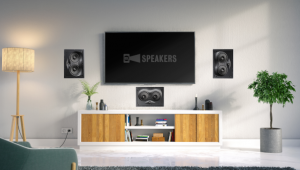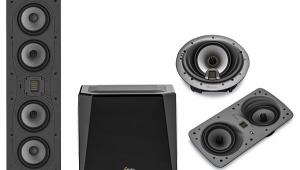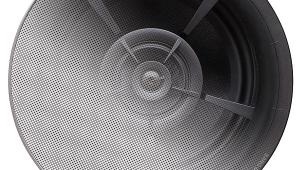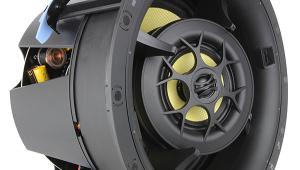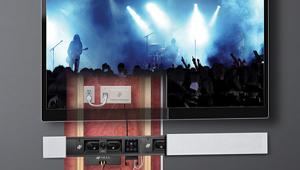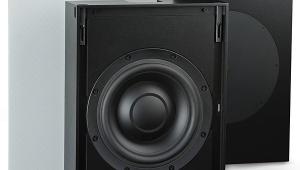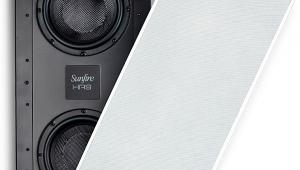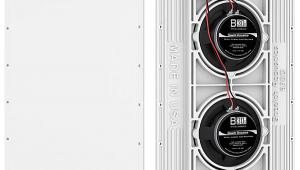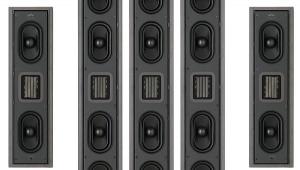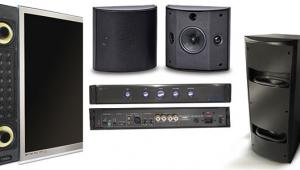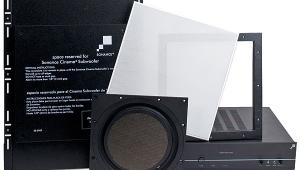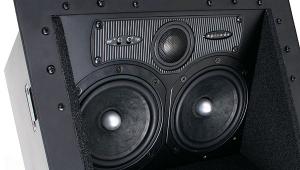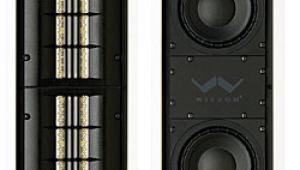Sheetrock 'n' Roll
If only Sheetrock dust were an aphrodisiac. After hacking and ripping my way through the installation of eight pairs of in-wall and in-ceiling speakers and one monumental pair of in-wall subwoofers, I'd be damn near the sexiest man alive. As it is, after the White Sands National Monument, my lungs are now the biggest repository of gypsum dust on the planet. Once again, I've risked life and limb to survey the state of the custom-install speaker industry and give you a feel for what your money can buy in terms of ease of installation, aesthetics, and—most importantly—sound quality.
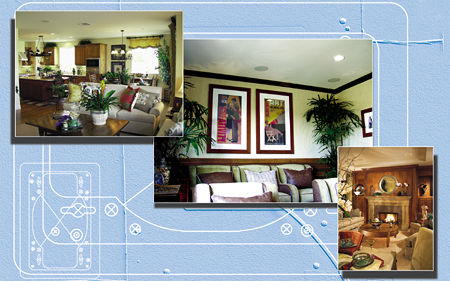
For those of you who are not part of the in crowd, in-wall speakers are (as the name suggests) speakers designed to be installed in your home's walls. Usually, they're rectangular in shape. In-ceiling speakers, which are traditionally circular in shape, are designed for installation in (surprise!) your ceiling. There's a time-honored tradition of rectangular-in-the-wall and circular-in-the-ceiling; break it at your peril, lest the hi-fi gods be offended and cause your home value to plummet and the toilets to run backwards. Actually, it's more that we're used to seeing rectangular things (like picture frames) on the wall and circular things (like light fixtures) on the ceiling. In reality, nothing but your sense of taste prevents you from using a rectangular speaker in the ceiling (or vice versa).
Since they use your walls as the speaker cabinet, most in-wall and in-ceiling speakers include all of the standard speaker elements except the box. While this reduces the cost and can make for easy installation, it also leads to variations in sonic performance due to construction variances. Even something as seemingly trivial as mounting a speaker in an inside wall (typically with no insulation) versus an outside wall (typically with insulation) can affect the speaker's mid- and bass-frequency response. To avoid this problem, some manufacturers build in-wall speakers with cabinets that are shallow enough to fit in most standard 4-inch walls (some require 6 inches of depth).
For years, in-wall and especially in-ceiling speakers have suffered from an image problem—and an imaging problem. Still, the allure of speakers that you can hide in the wall, up and out of the way, without visible wires is just too good for a lot of people to pass up. Quite a few manufacturers have worked hard to oblige the buying public with in-wall and in-ceiling speakers that not only look good but sound great, too. Quite frankly, even though I've been following the in crowd for a long time, I was surprised to find that the current selection is so good.
The following roundup is by no means all-inclusive, but it does cover a broad range of prices, styles, and approaches. They're presented here in ascending price order, so you can bail out once your budget is blown (but please read on to the end so that you can enjoy every morsel of information). I'll look at in-walls first and then move on to a couple of in-ceiling speakers.
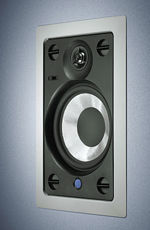 Russound SP-H6IM
Russound SP-H6IM
After years of making the parts and pieces necessary to pull a good wholehouse system together, Russound now offers a line of Advantage Iso-Mount in-wall speakers (plus several unique Twist & Tilt in-ceiling speakers). The term
Iso-Mount refers to a thermopolymer isolating gasket assembly that's sandwiched between the speaker baffle and the mounting frame. It reduces the transfer of vibrations from the speaker to the wallboard. It's an important performance-enhancing element that you'll rarely see in an in-wall in this price range.

On the surface, the SP-H6IM is a pretty traditional in-wall, employing a 6.5-inch long-throw woofer with a pivoting 0.8-inch aluminum dome tweeter. The speaker baffle is separate from the flange, which makes it easy to hold the flange in the wall while you tighten the eight dog-ear clamps that hold the flange securely in place. You secure the baffle with four twist-and-lock fasteners, so no tools are necessary to attach the baffle to the frame. Light, white fabric covers the inside of the aluminum grille, which virtually eliminates reflections off of the tweeter. A two-position high-frequency switch (0 and +3 decibels) and a knockout for an IR receiver eye are located on the baffle.
The SP-H6IM's sound is very respectable for an in-wall at this price. Vocals were especially nice (thanks in part, no doubt, to the Iso-Mount gasket), whether they were female (Ana Caram or Susan Tedeschi) or male (The Blind Boys of Alabama or Crash Test Dummies). Not surprisingly, however, the low-bass response was limited. The imaging, aided by the pivoting tweeter, was quite good. The Russounds really began to shine when I cut them off at 80 hertz and used them in combination with a powered subwoofer (like the Atlantic Technology monsters I'll describe later).

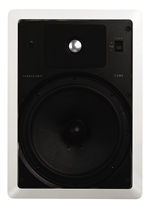 Parasound C 280
Parasound C 280
Parasound's C 280 is another traditional-style in-wall that combines a 1-inch aluminum dome tweeter with an 8-inch Kevlar woofer. Although the tweeter doesn't pivot (a feature that's fairly common nowadays), it's surrounded by a dense, foam-like material that reduces diffraction off of the front of the baffle. The back of the C 280's woofer basket has a piece of cloth on its top and sides to keep rodent excrement, Sheetrock particles, and insulation from falling into the voice-coil area—a feature you won't find on most of the speakers in this roundup. On the front, there's a knockout for an IR receiver and a three-position high-frequency switch (–3 dB, 0, and +3 dB). Thick, white felt cloth covers the inside of the heavy, metal grille (one of the sturdiest in the group), which keeps the shiny aluminum tweeter from making an annoying appearance behind the grille. Unfortunately, the line of sticky glue that holds the felt in place is plainly visible, an aspect that décor-minded individuals might find more jarring than the silver glint off of the tweeter. The cloth is easy to remove, however; so, for some people, that may be a solution.
The C 280 is a one-piece design, so installation is exceptionally quick and easy: Just tighten the front-baffle screws for the six dog-ear clamps, snap on the grille, and you're done.
The 8-inch woofer packed a pretty good punch, adding richness and authority to the opening guitar in Hadden Sayers Band's "Solitude" and really rocking on the Red Elvises' "Rocketman." With the felt cloth in place, the
C 280's overall sound was a little soft and reserved, perfectly suited for background music. However, I much preferred the sound with the felt removed. It became much more open and forward, which was a great benefit with a track like "Lester Leaps In" from Bucky Pizzarelli's Swing Live disc. As with the Russound speakers, the Parasounds blossomed wonderfully when I added the Atlantic Technology subwoofers.

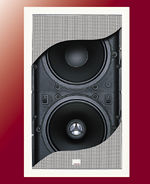 PSB M6x6.1
PSB M6x6.1
The PSB M6x6.1 is a departure from the norm among in-wall speakers in a couple of ways. First, it has a somewhat unique mounting system. Rather than dog-ear clamps, the M6x6.1 uses a two-piece mounting bezel with an inside-the-wall and an outside-the-wall component. The two pieces screw together, tightly clamping down on every inch of the wall between them. You then screw the speaker baffle into this rigid frame. It's not as fast an install as the dog-ear system, but it provides a more-rigid platform. It also allows for installations directly against a wall stud. While I liked the clamping flange quite a bit, I didn't care as much for the very transparent metal grilles that also include a tiny PSB logo at the bottom. (Logos on speaker grilles are anathema in many homes.) Fortunately, I easily removed said logos without a trace.
The M6x6.1's driver setup is also different, consisting of dual 6.5-inch polypropylene woofers and a 1-inch, pivoting, aluminum dome tweeter that's mounted on a pole that erupts from the center of the bottom woofer (like a coaxial car speaker). One of the woofers crosses over at 2,200 Hz, while the other plays 500 Hz and below. There are two-position adjustment switches for both the high and mid frequencies.

The M6x6.1's sound was quite stunning. While it didn't have all of the bass punch that you might get from an equivalently priced pair of freestanding speakers, you won't do much apologizing for these impressive in-walls' performance. Both the high and the low voices on the Blind Boys of Alabama's "People Get Ready" sounded excellent. With the M6x6.1s, you start to get a sense not only of imaging from left to right but of depth from back to front on SAVAE's "Abwoon." The only real flaw in the overall sound is a slight lack of phase coherency when you move from sitting to standing, although you can change the speaker's dispersion by reversing the jumpers on the tweeter. Of course, they kicked some serious butt with the addition of the Atlantic Technology subwoofers.

